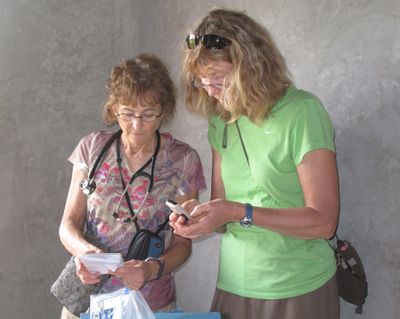Volunteers help Kenyan clinic
Locals get warm welcome, see overwhelming need

When North Side residents Sandy Ivers and Stacey Mainer first went to Kenya in 2007 to volunteer at a medical clinic in Kopanga, they were struck by people’s friendliness.
“Everybody is laughing and waving and smiling, very welcoming,” said Mainer, recalling how children came running, not with hands outstretched for money, but with cheerful faces and happy shouts of “mazungo, mazungo,” which means “white man.”
Driving through countryside barely scratched by signs of human life, they saw fields and herds that at night would lie dark under a sky filled with countless stars.
“Kenya is beautiful,” said Ivers. “Everywhere you cast your eyes is a picture.” She described mud huts with thatched roofs and more modern structures of stucco with tin roofs. “It is beautiful in a pastoral way.”
Along with Mainer’s husband, Dr. Michael Mainer, and Ivers’ son, Nick Ivers, the women went to help at a small medical clinic run by Alice Kephas, a Kenyan nurse. What they saw and experienced sparked a passion and prompted them to start a nonprofit, US Partners for Progress (P4P).
When they arrived at the two-room clinic, “it was appalling,” said Mainer, a nurse practitioner. It had very few supplies, no electricity and no running water. “It was so below standards for a doctor’s office.”
The town of Kopanga was no better. The community used the same 6-by-8-foot slough of muddy water for laundry, cooking and bathing, even though animals walk through it regularly.
“Three quarters of the diseases are preventable,” said Mainer. She described how, during one visit, they treated about 30 children who were urinating blood. They’d all swum in the same mud hole and picked up a fluke worm.
With limited access to clean water, many in the region suffer from malnutrition, dehydration, skin diseases and fungal infections. Add to that the high rate of HIV and malaria, and the sheer need could overwhelm. But Mainer and Ivers said they have been inspired by Kephas, whose vision to help her community is contagious.
“Alice says we can do it. There is something we each can do. If Alice can work that hard, the rest of us can do something,” said Mainer. “The encouraging part is I can see we can make a difference.”
Since that first trip, they have gone back several times, taking more medical staff to volunteer and raising funds throughout the year to help the community and clinic become more self-sufficient. So far they’ve raised $25,000, which helped build a new medical clinic this summer.
The goal, said Mainer, is to help the people of Kopanga help themselves, so that in about five years, P4P can move on to another community and repeat the process.
Rather than providing aid in a one-time visit, or even just sending funds, the organization is partnering with the community, working together to improve their access to medical care, education, sanitation and clean water. Together they are building the infrastructure so Kopanga can continue improving its quality of life and health. “You can’t go, give and walk away,” said Mainer.
They plan to visit the clinic twice a year, each time bringing more volunteer medical professionals. They treat residents, train clinic staff, and educate the community to help them prevent some of the common diseases that plague the country.
They share ways to prevent HIV and malaria through condom use and mosquito netting, and teach good health and hygiene practices like boiling water and washing hands. “It’s stuff we think is common knowledge,” said Ivers. “We need to help these people see what they can do to prevent HIV and water-borne illness.”
One day, said Mainer, they saw 140 people at the clinic. “The kids are thrilled to see you. The men and women are polite and smiling and soft-spoken.”
And each time they go back, they see progress.
More babies are born at the clinic, rather than at home, child mortality in the area has decreased, and they’ve seen decreases in malaria and the percentage of people testing positive for HIV.
The women spoke of cases they can’t forget: the mom whose husband kicked her and her two daughters out when she tested positive for HIV, the children who’ve died from preventable water-borne illnesses. They also remember those they’ve helped, and the Kopanga people’s pleas that they never forget.
“They are pretty desperate that we remember them,” said Ivers, noting this propels them to keep working every week – raising funds, raising awareness and recruiting volunteers.
“When you go, you know you have to go back,” said Mainer. “You never stop thinking about it, the faces of these little children. That keeps you going. We have a mission.”